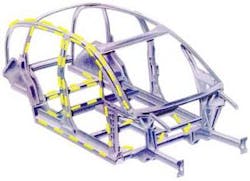H. Staufer, M. Rührnößl and G. Miessbacher
Laser welding requires high power and a high-quality beam to obtain the desired deep-weld effect. High-quality beams can also be used to obtain a smaller focus diameter or a larger focal distance. For the projects described in this article, a lamp-pumped solid-state laser with a laser beam power of 4 kW is being used. The laser light is transmitted via a 600mm glass fiber in which the entrance and the exit are water-cooled. The laser beam is projected onto the workpiece by a focusing module with a focal distance of 200 mm.
Hybrid process
Figure 2 illustrates the basic principle of hybrid welding, with the laser beam feeding heat to the weld metal in the top part of the seam, in addition to the heat from the arc. Unlike a sequential configuration where two separate weld processes act in succession, hybrid welding may be viewed as a combination of both weld processes acting simultaneously as one in the same process zone. Depending on which arc or laser process is used, and depending on the process parameters, the processes will influence one another to a different extent and in different ways.1,2
For welding metallic workpieces, the Nd:YAG laser beam is focused at intensities above 106 W/cm2. When the laser beam energy hits the surface of the material, it heats up a spot to vaporization temperature, and a vapor cavity is formed in the weld metal due to the escaping metal vapor. The distinguishing feature of the resulting weld seam is its high depth-to-width ratio. The energy density of the freely burning arc is slightly above 104 W/cm2. Through the combination, there is also an increase in both the weld penetration depth and the welding speed (as compared to either of the processes used on its own). The metal vapor escaping from the vapor cavity retro-acts upon the arc plasma. Absorption of the Nd:YAG laser radiation in the processing plasma remains negligible. Depending on what ratio of the two power inputs is chosen, the character of the overall process may be determined to a greater or lesser degree either by the laser or by the arc.3,4
Before the laser welding process can begin, the initial workpiece surface reflectance must be overcome, especially on aluminum, by starting welding with a special start program. After the vaporization temperature has been reached, the vapor cavity is formed, with the result that nearly all the laser beam energy can be input into the workpiece. The energy required is determined by the temperature-dependent absorption and by the amount of energy lost by conduction into the rest of the workpiece. In laser-MIG welding, vaporization takes place from the surface of the workpiece and also from the filler wire. This means there is more metal vapor available, which facilitates the input of the laser radiation and prevents process dropout.
Automotive application
Today, by using aluminum space frame technology, a weight reduction of 43 percent is possible in comparison to a steel car body. The Audi A2 space frame consists of 30 m of laser weld (yellow strips in Figure 1) and 20 m of MIG weld length. Additionally, 1700 rivets are used. Figure 3 shows a laser-MIG welded joint of an AlMg3 cast material with a AlMgSi sheet material. The filler wire is AlSi5, and argon is used as the shielding gas. With increasing laser power, deeper penetration is possible. Combining the laser beam with the arc in joining techniques achieves a larger weld pool than with the laser beam weld process on its own, which makes it possible to weld components with wider gaps.
In the automotive industry there are many applications of overlap welding without joint preparation. Currently, the state-of-the-art process is welding with a cold filler wire, due to hot cracking of the AA 6xxx alloy (see Figure 3). When laser welding with a filler wire, considerable energy is used to melt the wire. Figure 4 shows the differences between laser-MIG and laser welding at a welding speed of 2.4 m/min on an overlap joint. In this case the weld bead is not filled and undercut is produced. Also, there is only a very small penetration into the base material. The weld bead width is very small, and therefore a low tensile strength will be expected.
When laser-MIG welding, additional material is transported into the weld pool, the undercut is filled with the wire from the MIG process and a portion of laser energy is now saved. The laser energy saved can be used to increase the penetration into the base material, and the weld bead width is bigger than the material thickness, which is required from the numerical simulation.
With the laser-MIG welding procedure it is possible to weld aluminum, steels and stainless steel up to 4 mm in material thickness. If the thickness is too high, full penetration is not possible. For joining zinc-coated materials, it is preferable to use the laser brazing process. Further applications where the laser hybrid welding process can be suitable in the automotive industry could be power trains, axles and car bodies.
Welding head
For auto body applications the welding head should be small to ensure good accessibility to the components to be welded. It should also be detachable from the robot head with adjustability of focal distance and torch stand-off distances in all Cartesian coordinates. Welding process spattering leads to increasing soiling of the protective glass, which can cause the laser power at the workpiece to decrease by as much as 90 percent.
Advantages of laser-MIG welding
Advantages of hybrid welding over laser welding include higher process stability, higher bridgeability, deeper penetration, lower capital investment costs and greater ductility.
The advantages of hybrid welding over MIG welding include higher welding speeds, deeper penetration at higher welding speeds, lower thermal input, higher tensile strength and narrower weld-seams. Laser-MIG welding thus makes for higher welding speeds, process stabilization due to the interaction between the arc and the laser beam, increased thermal efficiency and greater workpiece tolerances. Because the weld pool is smaller than in the MIG process, there is less thermal input and thus a smaller heat-affected zone. This means less weldment distortion, which reduces the amount of subsequent post-weld straightening work.
Where there are two separate weld pools, the subsequent thermal input from the arc means that the laser-beam welded area—especially in the case of steel—is given a post-weld tempering treatment, spreading the hardness values more evenly across the seam.
From an economic standpoint, the hybrid weld process requires reducing the laser power. A reduction of 1 kW in the Nd:YAG laser beam power leads to a reduction of approximately 35 kVA in the electric power consumed. Thus, in the hybrid process it is possible to use a 2 kW laser instead of 4 kW, resulting in savings in investment outlays. However, for the hybrid process, a MIG machine will also be needed. But due to the higher welding speed, both the fabrication time and the welding cost can be reduced.
Summary
Laser-MIG welding offers synergies for wide fields of application in metalworking industries, especially where it is not possible or financially viable to achieve the component tolerances that are required for laser beam welding. The much wider range of application and the high capability of the combined process lead to enhanced competitiveness in terms of reduced investment outlays, shorter fabrication times, lower manufacturing costs and higher productivity.
The laser-MIG process also offers a new approach to welding aluminium. Basic research studies 5, 6, 7, 8, 9 have shown the combined processes compensate for the drawbacks of each separate process, resulting in enhanced welding possibilities, weldability and welding reliability for many different materials and constructions.
null
By choosing favorable process parameters, it is possible to selectively influence aluminum alloy weld properties such as geometry and structural constitution. The arc welding process increases the bridgeability by adding filler metal and it determines the weld-seam width, reducing the amount of workpiece preparation needed. Moreover, the interactions taking place between the processes lead to a substantial increase in the efficiency of the process, and this combination process also requires considerably smaller investment costs than does the laser welding process.
The authors are with Fronius International. For further information in North America call Fronius USA at (810) 220-4414 or fax (810) 220-4424.
REFERENCES
- Dausinger, F., Hohe Prozeflsicherheit beim Aluminiumschweiflen mit Nd: YAG-Lasern Bleche und Profile 42 (1995) Nr.9, S.544-547.
- Cui, H.: Untersuchung der Wechselwirkungen zwischen Schweißlichtbogen und fokussiertem Laserstrahl und der Anwendungsmöglichkeiten kombinierter Laser-Lichtbogentechnik. TU Braunschweig, Dissertation, 1991.
- Maier, C., Beersiek, J., Neuenhahn, K., Kombiniertes Lichtbogen—Laserstrahl-Schweißverfahren—Online-Prozeßü¸ berwachung. DVS 170 (1995) S.45-51.
- Steen et al. "Arc-Augmented Laser Welding," 4th Int. Conf. on Advances in Welding Processes, Paper No.17 (1978) pp.257-265.
- Steen, Laser Material Processing, Springer Verlag, 1996.
- Schweißen mit Festkörperlasern, Laser in der Materialbearbeitung, Band 2, VDI- Verlag, 1995.
- Beyer, E., Schweißen mit Laser, Grundlagen, Springer-Verlag, 1997.
- Faißt, F., Weick, J.M., Fitz, R., Kern, M., "Anwendungen der Twinfokus-Technik," Stuttgarter Lasertage 19 99. S.50-52.
- Helten, S., Qualifizierung und Implementierung des lichbogenunterstützten Lasersrahlschweißverfahrens in den Fertigungsprozeß im Aluminiumkarosserieleichtbau. Diplomarbeit Audi, RWTH (ISF) Aachen 1999.




